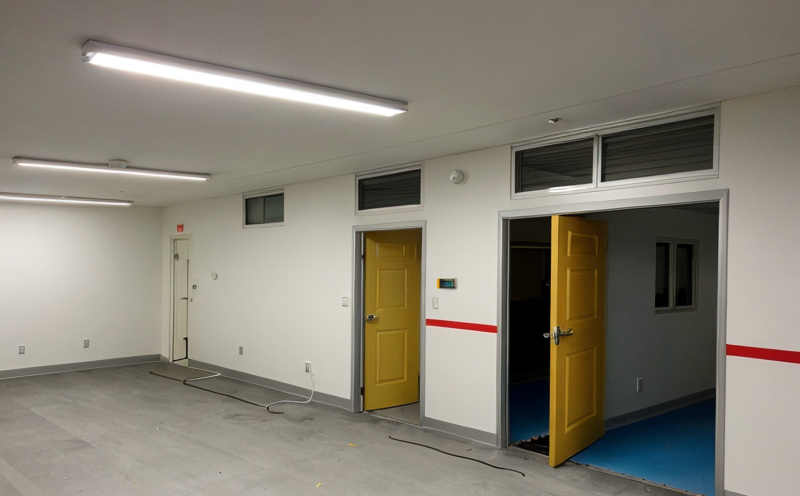IEC 60929 Emergency Lighting Testing of Fluorescent Ballasts
The International Electrotechnical Commission (IEC) Standard IEC 60929 is a pivotal document for the testing and certification of fluorescent ballasts used in emergency lighting systems. This standard ensures that these devices meet stringent performance criteria, which are critical for maintaining safety during power outages or other emergencies.
Fundamentally, fluorescent ballasts play a crucial role in emergency lighting by providing the necessary voltage to activate the light source (fluorescent lamp) and regulate its current consumption. This regulation prevents overheating and damage to the lamps and prolongs their operational life. In an emergency situation, where power supply is intermittent or lost entirely, the integrity of these ballasts becomes paramount.
IEC 60929 sets out comprehensive requirements for testing fluorescent ballasts with regard to their efficiency, stability, and safety features. These tests are essential not only for compliance with international standards but also for ensuring that emergency lighting systems can reliably function when needed most. The standard covers various aspects including electrical performance parameters such as power factor correction (PFC), inrush current limits, operating frequency range, and more.
The testing process involves rigorous procedures aimed at evaluating the ballast’s ability to provide stable output voltage across different load conditions. Additionally, it assesses how effectively the ballast handles overcurrent and overload situations without compromising safety or performance. Compliance with IEC 60929 ensures that emergency lighting systems are reliable under all specified operating conditions.
For fluorescent ballasts specifically designed for use in emergency lighting applications, additional considerations include their ability to start and maintain operation even when the input voltage is reduced significantly due to power fluctuations during an outage. The standard also addresses environmental factors such as temperature ranges within which the ballast must operate correctly.
The importance of adhering strictly to IEC 60929 cannot be overstated, especially given today’s emphasis on sustainable and efficient lighting solutions. By ensuring that fluorescent ballasts meet these stringent requirements, manufacturers can provide products that not only comply with regulatory standards but also contribute positively towards energy conservation efforts.
In conclusion, IEC 60929 emergency lighting testing of fluorescent ballasts is crucial for guaranteeing product reliability and safety in critical applications. It helps ensure that emergency lighting systems remain operational during emergencies, thereby enhancing public safety and protection against potential hazards associated with power disruptions.
Why It Matters
The implementation of IEC 60929 testing is crucial for ensuring the reliability and safety of emergency lighting systems. Compliance with this standard guarantees that fluorescent ballasts used in these applications will perform consistently under various conditions, including power fluctuations often encountered during emergencies.
By adhering to the stringent requirements outlined by IEC 60929, manufacturers can demonstrate their commitment to quality assurance and customer satisfaction. This not only builds trust among end-users but also facilitates easier adoption of new technologies into existing infrastructure without compromising on standards.
In addition to enhancing user confidence, strict adherence to this standard supports broader goals related to sustainability and environmental responsibility by promoting the use of efficient lighting solutions that minimize energy consumption while maintaining optimal performance levels.
Scope and Methodology
| Test Parameter | Description |
|---|---|
| Inrush Current Limitation | The maximum allowable current drawn by the ballast during startup. |
| Operating Frequency Range | The range of frequencies at which the ballast must operate correctly. |
| Power Factor Correction (PFC) | The efficiency with which the ballast converts input power into useful output power. |
| Overcurrent and Overload Handling | The ability to safely handle excessive current or load without failing. |
| Temperature Range Compatibility | The range of environmental temperatures within which the ballast must function properly. |
The testing methodology specified in IEC 60929 involves subjecting fluorescent ballasts to a series of controlled tests designed to assess their compliance with all relevant parameters. These tests include measuring electrical characteristics such as power factor correction (PFC), inrush current limitations, operating frequency ranges, and more.
Additionally, the standard mandates testing under different environmental conditions including varying temperatures. This ensures that the ballasts can perform reliably across a wide range of potential operational scenarios. The results from these tests provide assurance about the reliability and safety of the fluorescent ballasts in emergency lighting applications.
Industry Applications
- Hospitals, where uninterrupted light sources are vital for patient care during emergencies.
- Data centers, ensuring critical operations continue even when regular power supplies fail.
- Retail stores and commercial buildings, providing necessary lighting during unexpected power outages.
- Public transportation hubs, maintaining safety by keeping essential areas well-lit during disruptions.
The application of IEC 60929 emergency lighting testing extends beyond just fluorescent ballasts; it encompasses the entire system ensuring that all components work seamlessly together. This holistic approach guarantees that when an emergency strikes, every part of the lighting setup functions as intended, providing reliable illumination where it’s needed most.





